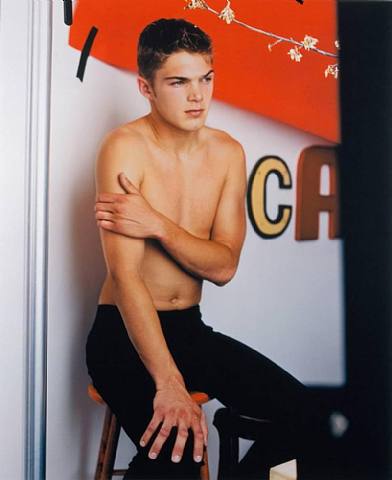A new book of photographs by Jack Pierson features 15 images of beautiful men, arranged to suggest the arc of a lifetime — beginning with a young boy and progressing to old age with men in various stages of undress. There’s nothing surprising about that; Mr. Pierson has been photographing beautiful naked men for years. In this case, though, the photographs are offered under the title ”Self Portrait.” But none of the images is of the artist himself.
Mr. Pierson has fashioned an autobiography from a collection of images of unidentified men. His photographs affect the casual look of a vacation snapshot, one you might expect to find clipped to a page of a personal diary. Often there is an implicit, offhand eroticism to his pictures of men, as if something sexual is in the cards, or might have just taken place.
While there is a canny intimacy to these new pictures, languorously attuned to the temporal glamour of ordinary moments, the subject of this self-portrait series is desire — when it begins, how long it lasts, what it tells us about ourselves or, at least, about the artist.
Mr. Pierson is part of a group of photographers known as the Boston School — David Armstrong, Philip-Lorca diCorcia, Nan Goldin and Mark Morrisroe, among others. All of them knew one another in the early 1980’s and photographed their immediate circle of friends in situations that were, or appeared to be, casual or intimate. Mr. Pierson was often the subject of Mr. Morrisroe’s photographs, and the object of Mr. Morrisroe’s desire. The photographs in this self-portrait series take their cue from the template of pictures of the artist taken 20 years ago. In an attempt to establish a mythology of self, Mr. Pierson is presenting new photographs of other men in the manner of his own portrait, claiming their appearance to represent his own identity. The book is published by the Cheim & Read gallery in Chelsea, where the exhibition ”Jack Pierson,” featuring other works of his, runs through Jan. 3.
”Self Portrait” is the flip side of what Cindy Sherman accomplished in her series ”Untitled Film Stills.” Dressing up to enact a wide variety of female archetypes, Ms. Sherman photographed herself in fictional scenes alluding to Hollywood films. That body of work expresses an idea about the way identity is formed by the cultural forces all around us; yet, despite Ms. Sherman’s insistence that her ”film stills” are not self-portraits, the series flirts with the very idea of identity and self-portraiture. Mr. Pierson, by eliminating his own likeness from his ”Self Portrait,” comments on the same postmodern idea about the cultural construction of the individual, but in this case the work suggests that assumed identities both define and obscure the individual in society.
The idea of the constructed identity is nothing new. In an age of cosmetic surgery and on-line communication, it’s easy to customize our appearance or hide behind an invented persona. How often do we look at a picture in a magazine and imagine ourselves with that haircut, in those sunglasses, on that beach? No matter how strong our own sense of who we are, the lust for some idealized version of ourselves is invariably summoned in the barrage of images endlessly flashing before us. Mr. Pierson’s self-portrait series attests to this, underscoring at its core his own erotic impulse to be as desirable as those he desires, to become the very object of his own attraction.
In naming his pictures of others ”Self Portrait,” Mr. Pierson also owes a nod to the Dada legacy of provocation. The catalog of ”The First Papers of Surrealism,” a 1942 group exhibition in New York organized by Marcel Duchamp and André Breton, used the self-portrait as a symbolic equivalent in photographs and drawings of completely unrelated or unknown people. Titled with the names of the participating artists, these ”ready made” portraits, or found faces, took on new meaning in place of other expected identities.
In an essay for a show of portraits at PaceWildenstein Gallery in 1976, Kirk Varnedoe wrote, ”If, in the extremes of modern portraiture, the artist sees the other almost wholly as himself, so in the self-portrait he often sees himself as somebody, or something, irrevocably ‘other.’ ”
Portraiture has always revealed as much about the artist as the subject. If you think about the difference between portraits by Richard Avedon and Robert Mapplethorpe, each photographer has a signature style. Remove the names of their subjects and you’re left with a collection of portraits that become as much a self-portrait as the artist’s own likeness. In effect, Mr. Pierson has taken that idea one step further by omitting the names of his subjects, assuming their identities and calling his collection ”Self Portrait.”
Picasso, unsatisfied with the face of his portrait of Gertrude Stein after 80 sittings, painted one based on a mask of an Iberian sculpture. When people protested that the portrait did not resemble the subject, he is said to have commented: ”Everybody thinks she is not at all like her portrait, but never mind. In the end, she will manage to look just like it.”
By PHILIP GEFTER
Published: December 18, 2003
VIA http://www.marcellosimeone.com/blog/jack-pierson-self-portrait-as-obscure-object-of-desire.html


No comments:
Post a Comment